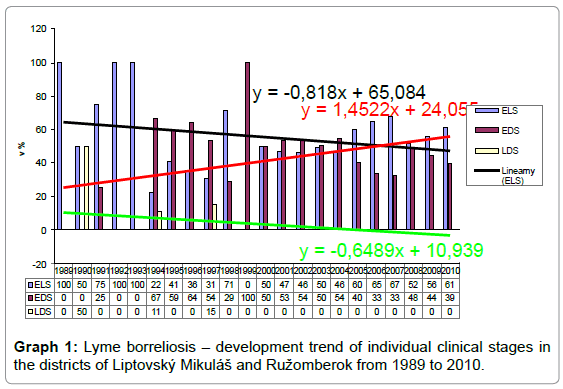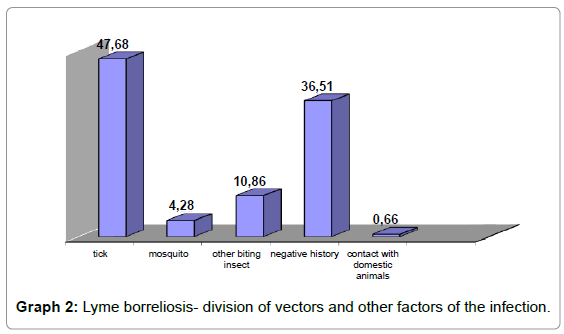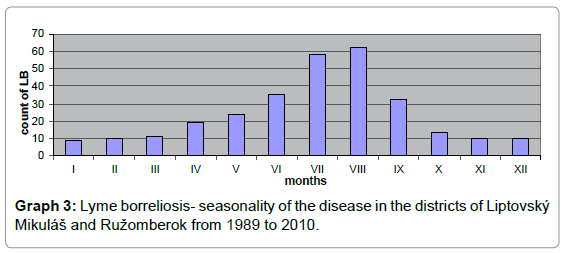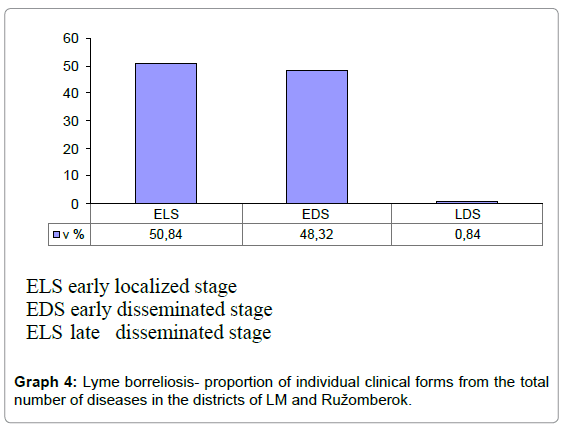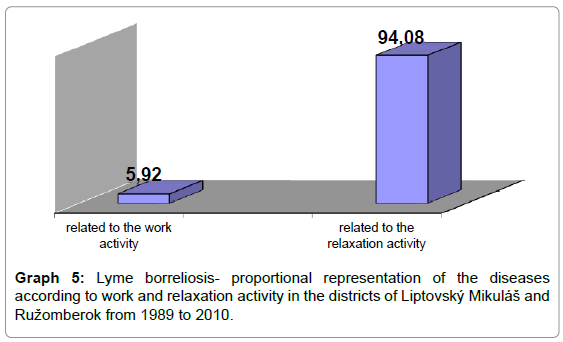Lyme Disease in Northern Slovakia (1989-2010): Clinical and Epidemiological Characteristics
Received: 26-Feb-2013 / Accepted Date: 26-Jun-2013 / Published Date: 29-Jun-2013 DOI: 10.4172/2161-1165.1000125
Abstract
In recent years, the incidence of Lyme borreliosis has been on an upward trend also as a result of global warming, not only in our region. In the prospective and also retrospective study we have monitored the representation of individual forms of borreliosis in the set of 476 patients treated for this disease for the period of 22 years (1989-2010). From the total set of 476 patients, the treatment was initiated in the early localized stage in 50.84 % (n = 242), and the disease was diagnosed in the early disseminated stage of Lyme disease in 48.32 % (n = 230). The late disseminated stage of the disease has developed only in 4 cases (0.84 %). We focused on the epidemiological history- information about the tick acquisition was confirmed in 47.68 % (n = 227), the vector of the disease transmission, which is a tick in most cases, the seasonality- the highest number of cases of the disease development was in July and August: 39.92 % of the cases (n = 190), and the locality of the disease development with creating the map of sources of Lyme borreliosis in the northern region of Slovakia. We divided the set of patients also according to the risk of exposure to the vectors: the infection was transmitted to humans during recreational activities in 94.11 % (n = 448).
Keywords: Early localized stage; Early disseminated stage; Tick; Seasonality; Recreational activity
160059Introduction
Lyme borreliosis is the most common disease transmitted by ticks in Slovakia. The number of cases is growing and chronic stages are a menace not only to the patients and physicians, but also to the epidemiologists. Therefore, everybody concerned should try to make the nationwide surveillance of the disease, which we attempted to do also in our region, and it was the result of our 22-year study. The disease is divided into the early stage- localized and disseminated, and the late disseminated stage. The disseminated stages are imitators of many other diseases, so the diagnosis and treatment are more difficult.
Objective
To divide the set of patients treated with the diagnosis of Lyme borreliosis from 1989 to 2010 in the Liptov region by:
1. Individual clinical stages of the disease
2. Stated vector of the disease
3. Seasonality of the disease
4. Activity related to the commencement of the disease
5. Geographic location of the vector acquisition, i.e. to identify natural sources with creating the map of risk areas in the districts of Ružomberok and Liptovský Mikuláš
Materials and Methods
The Liptov region consists of the districts of Liptovský Mikuláš and Ružomberok, with the area of 1,970 square kilometers. Approximately 140,000 inhabitants live in three towns: Liptovský Hrádok, Liptovský Mikuláš and Ružomberok, also in 74 villages (the largest are Važec, Východná, Hybe and Bobrovec). Liptovská Basin (Liptovská kotlina), with a length of 50 km and a maximum width of 15 km, which is enclosed in the mountain rim of surrounding mountains, is the core of the area of Liptov. The northern part of the basin is bordered by the Western Tatras (Západné Tatry) (Roháce), whose ridge to the east from Volovec forms the state border with Poland. Low Tatras (Nízke Tatry) form 80 km long barrier that separates the Liptov region from the Pohronie region. In the northwest, Liptov is separated from Orava by Chocské Mountains (Chocské vrchy). Liptov altitude ranges from 430 meters (at the confluence of Orava and Váh) to 2,248 meters- the Bystrá mountain in the Western Tatras. In the Liptov region, forests represent a basic landscape and environment stabilization element of the area with 60% forest cover. The forests cover 130,000 hectares of Liptov. The range of uplands is represented minimally only in the western part of the region- the village Stankovany with oak-hornbeam forests. The submontane zone from 500 to 1,000 m a.s.l., originally covered by beech or beech-fir forests, preserved originally only in the area of Chocské Mountains (Chocské vrchy), is replaced by spruce monocultures in the rest of the area. The forest communities of Chocské Mountains (Chocské vrchy) are composed of 20% spruce forests, 40% mixed forests and the beech forests only 8 % of the protected reserve. Greater incidence of the beech trees is especially in L’ubochnianska Valley (L’ubochnianska dolina)- up to about 30%. On the southern edges of the mountains, there are submontane meadows, pastures and urbane biotopes (to the north from the town of Ružomberok). With regard to the location and high elevation differences, the climate of the region is very diverse. The warmest part of the Liptovská Basin is near the Váh river, which belongs to the temperate climate with an average annual temperature 6 degrees Celsius. Towards to mountains, the temperature decreases and in the top parts of the mountain ranges it drops to 2 up to-30 degrees Celsius. The area is characterized by a small number of summer days, whose average number per year in the warmest part of the basin is 30. The average rainfall is 737 mm. Lyme borreliosis in Liptov region was diagnosed for the first time in 1989, since then not only diagnostic methods, but also knowledge about the disease itself have undergone a major development. The Ministry of Health of the Slovak Republic determined the procedure of diagnosing and reporting the disease by the Methodical Letter in 1990. From the obtained set of patients we excluded cases with other diagnoses for the possible cross positivity of antibodies (chlamydial infection, herpes simplex, Helicobacter pylori, as well as epilepsy and multiple sclerosis). We obtained a set of 476 patients treated for the diagnosis of Lyme borreliosis according to medical documentations of the departments of infectious diseases of the hospitals in the region. We divided the set according to the diagnosed stage of the disease, seasonality, locality of the disease development and work activity of the patient. The diagnosis of borreliosis was established on the basis of comprehensive assessment of epidemiological anamnesis, clinical symptoms and serology of antibody against antigen Borrelia burgdorferi using immune fluorescent method (1989-1995), from 1996 by method ELISA and from 2008 by methodology Western blot. For achieving the objectives of work, we used the following mathematical and statistical methods of data evaluation. Besides the classical calculation of percentage of the observed phenomenon, the frequency of disease is expressed by prorata number calculated per 100,000 inhabitants- total morbidity. In assessing the individual morbidity of individual age groups or sexes, the morbidity was calculated per 100,000 inhabitants of the respective age group or sex-specific morbidity. The average annual morbidity was calculated from the average number of diseases calculated for the average number of inhabitants in the respective district. The results of the calculations are numerically presented in the table, graphs and map. In the graphical presentation of the results, the trend is shown in time series of values by a regression line. It expresses the dependence of total morbidity from time with the use of the method of linear regression, where linear dependence of the changes of a dependent variable.
(Morbidity) from the changes of an independent variable (years 1989- 2010) was presumed. We compared the values of incidence of the early localized and the early disseminated stage by the two-phase variance t-test.
Results
Lyme borreliosis is disease with a relatively short history, especially in Slovakia. In the district of Liptovský Mikuláš the first case of Lyme borreliosis was diagnosed as late as in 1989, in Ružomberok 2 years later. For the next 22 years the number of cases stopped at the number 476 for districts, 280 patients in Liptovský Mikuláš and 196 cases of the disease in Ružomberok. From the original set we excluded 195 patients with a different disease, for the possible cross positivity of antibodies. Morbidity according to gender was higher in women than in men. From the total number of diagnosed disease women accounted for 62.48% (n = 305) and men 37.52% (n = 171). The age-specific morbidity analysis for 1989- 2010 shows that the most exposed groups was 45 to 54 year old and 35 to 44 year old adults. The average annual morbidity was 21.1 and 18.21. The lowest morbidity was among 0 to 4 years old children From all clinical stages of the disease on LB we recorded a downward trend in the stage of early localized infection, on the other hand early disseminated stage has a slight upward trend. Both groups have the same mean values (p = 0.05). The late disseminated stage is on significant decline, since 1998 was not recorded any disease in this clinical stage (Graph 1). The stage of the early localized infection was the most common and it occurred in 50.84 % (n = 242). The early disseminated stage occurred in 48.32 % (n = 230) of the cases of Lyme borreliosis (p = 0.05), the stage of the late disseminated infection only in 0.84 % of the cases (n = 4). From the clinical forms of the individual stages, in the stage of the early localized infection erythema migrans occurred in 71.07 % (n = 172), and the early form was determined in 28.93 % of the cases of the disease (n = 70) without the occurrence of erythema with only nonspecific symptoms. (Graph 1 and Graph 4; Table 1) From the total number of the early disseminated stages of Lyme borreliosis the musculoskeletal form accounted for 56.09 % (n = 129) and the neurological form 40.43 % (n = 93). The articular and neurological form of the early disseminated stage predominated in women, the ocular form occurred only in women. The cutaneous form of the late disseminated stage occurred only in men. The cardiological and ocular form accounted for 1.74% of the diseases of the early disseminated stage of Lyme borreliosis. Affecting the cardiovascular system with Borrelia infection in two men (13-year-old boy, 50-year-old man) and two women clinically manifested itself as myocarditis, pericarditis, then extrasystolia and tachycardia. The ocular form of the infection was in 3 cases caused by chorioretinitis and once by uveitis. Among the neurological forms the most common was cranial nerve paresis-38.70% of the cases (n = 36), of which mostly facial nerve paralysis 66.66% (n = 24). From other cranial nerves the affected ones were 3rd cranial nerve (diplopia), trigeminal nerve and statoacoustic nerve. Post- Lyme syndrome with persisting symptoms such as fatigue, headaches, muscle and joint pain, sleep disturbances, cognitive impairment lasting more than one year after an adequate treatment occurred in 10.29% (n = 49) (Table 1). In 47.68% (n = 227) the tick acquisition was reported, in 4.28% (n = 20) the mosquito bite, in 10.86 % (n = 51) bite of another biting insect, but up to 36.51% (n = 174) of patients did not state the type of the vector (Graph 2). The highest number of cases in the monitored period from 1989 to 2010 was recorded in July and August, 120 manifest diseases, which represented 25.21% of all diseases (Graph 3). In terms of geographic localities, the rural population was most exposed to the assumed infection- 56.02 % (n = 267) (Map). In towns and the nearby area, 31.94 % (n = 152) of patients became infected. According to data obtained from medical histories, the majority of tick acquisitions were reported in the town of Liptovský Mikuláš (37.89 %) and in the town of Liptovský Hrádok (11.58%). From other villages, the percentage of localities of acquisition ranged from 1.05 to 6.32% in Liptovská Sielnica. In the district of Ružomberok, the inhabitants of the town of Ružomberok were most exposed (34.25%). From other villages, the percentage of localities of acquisition ranged from 1.37 to 9.59% in L’ubochna and 10.96 % in Liptovská Lúžna. The acquisition of the tick or other insect in the monitored period according to data from the medical histories of patients occurred during activities related to recreational activity 94.08% (n = 448) and work activity in 5.92% (n = 28) (Graph 5). The analysis of morbidity of Lyme borreliosis according to the permanent address of the patients showed the highest average annual morbidity in the district of Liptovský Mikuláš- in the villages Prosiek, Malé Borové and Bukovina (92.39; 85.43; 83.97/100,000 inhabitants). In the district of Ružomberok the average annual morbidity was 37.50/100,000 inhabitants in the villages L’ubochna and Valaská Dubová 21.85/100,000 inhabitants (Map).
| Clinic stages | Clinic form | Men | Women | Total | Representation of the clinical forms of the total number of diseases LB | ||
|---|---|---|---|---|---|---|---|
| abs. | % | abs. | % | abs. | % | ||
| Early localized stage | EM | 56 | 71,25 | 116 | 71,16 | 172 | 36,13 |
| without erythema | 23 | 28,75 | 47 | 28,83 | 70 | 14,71 | |
| Total | 79 | 100,00 | 163 | 100,00 | 242 | 50,84 | |
| Early disseminated stage | musc-scelet | 47 | 53,41 | 82 | 56,34 | 129 | 27,10 |
| neurologic | 39 | 44,32 | 54 | 38,03 | 93 | 19,54 | |
| kardiologic | 2 | 2,27 | 2 | 1,41 | 4 | 0,84 | |
| ocular | 0 | 0 | 4 | 2,81 | 4 | 0,84 | |
| Total | 88 | 100,00 | 142 | 100,00 | 230 | 48,32 | |
| Late disseminated stage | dermatologic | 2 | 50,00 | 0 | 0 | 2 | 0,42 |
| neurologic | 2 | 50,00 | 0 | 0 | 2 | 0,42 | |
| Total | 4 | 100,00 | 0 | 100,00 | 4 | 0,84 | |
| All | 171 | 35,92 | 305 | 64,07 | 476 | 100 | |
Table 1: Lyme borreliosis - clinic forms in districts Liptovský Mikuláš and Ružomberok from 1989 to 2010.
Discussion
The upward trend of the diseases from 1989 to 2010, i.e. from the beginning of monitoring of the disease in Slovakia as well as the Czech Republic, is confirmed also by monitoring in the catchment area of Liptovský Mikuláš [1]. In the Slovakia-wide scale, this fact was influenced by several factors- improvement of physicians’ awareness about the new disease, improvement of the warning duty, introduction of new methods, but also by global warming. In 1980s ticks occurred only to the altitude of 800 meters a.s.l. Nowadays they occur also in the altitude of 1200 meters a.s.l. Thanks to the research of the Slovak Academy of Sciences and the Slovak Institute of Parasitology in Košice we have data about ticks infected with Borrelia in mountainous regions of Slovakia [2,3]. The highest detection rate of the disease is in the early stage, which is the most optimistic in terms of success of treatment as well as prognosis of Lyme borreliosis. From clinical stages, in Liptov region the stage of the early localized infection is represented with the highest percentage, which prevails over the early disseminated stage by 2%. In the early stage the prevailing form is erythema migrans- in 71%, which corresponds to experience from the published scientific works of domestic as well as foreign authors [4,5]. European countries, also the Czech Republic [6] are reported in the first place of occurrence of the erythematous form of borreliosis. From the total number of patients treated for Lyme borreliosis, the patients with erythema migrans had the highest representation, and the patients with the musculoskeletal form of the disease in the early disseminated stage were in the second place. The early disseminated stage is on a moderately upward trend also thanks to improvement of diagnostic methods and education of physicians. In the past, the manifestations of the disease were treated as polyarthralgia by other specialists, not by infectologists. In recent years, especially the musculoskeletal form of the early disseminated infection is on an upward trend in women. The actual number of diseases with this diagnosis was twice as high, but for the possible cross positivity of antibodies against other originators of diseases (especially antibodies against chlamydia) we excluded the female patients from the set. In the early disseminated stage of infection, articular symptoms occurred most frequently, contrary to literary quotations, which state that neurological symptoms have a priority representation [7]. This difference may be due to the occurrence of individual Borrelia genospecies. More than a half of musculoskeletal forms of the disseminated stage of Lyme borreliosis occurred in women [8]. In the prospective study in Sweden assume the occurrence of unknown mechanisms that determine sex differences in the incidence of the disease, and they explain this difference by the type of an immunological response in postmenopausal women [8]. A German study also states a higher incidence of neuroborreliosis in females [7]. In Liptov region the neurological symptoms occurred in the third place, with the highest representation in the male population. In younger age groups the manifestation was especially facial nerve palsy (4-year-old and 9-year old child, 20 to 35-year-old men), whereas older patients experienced symptomatology of vascular encephalopathy (vertigo, hemiparesis). A Swedish study states the proportion of Borrelia infection 65% of all cases of facial nerve palsy in children [9]. The increased incidence of neuroborreliosis in children is caused by the vector acquisition in the upper part of the body and a quicker dissemination of the pathogen than in adult patients [10]. There was also an occurrence of 2nd and 3rd cranial nerve palsies, and rare auditory nerve palsy, which was also under diagnosed like the ocular forms of the disease. A case of 20-yearold man was interesting, in whom the infection manifested itself by a sudden psychotic state, which completely disappeared after parenteral administration of 3rd generation cephalosporins. The ocular forms were recorded only in 4 cases, and certainly their number in the ophthalmology outpatient departments is under diagnosed and they escape the attention. The late disseminated stage is declining significantly, no case has been recorded since 1998, and this downward trend is an optimistic confirmation especially of the higher level of laboratory and clinical diagnostics of the disease in earlier stages. Only 5 patients were treated in the stage of the late persistent infection, with the cutaneous form of ACA only men, and neurological manifestations occurred in both sexes. The severity of Lyme borreliosis is conditioned by the variability of genetic information of Borrelia and long persistence in the body. The persistence of symptoms may be caused also by a late diagnosis of the disease, insufficient duration of treatment, bacterial persistence and autoimmune mechanisms (molecular mimicry) [11]. The picture of the disease is induced by taxonomically distinct types of Borrelia, of which there are several species in Europe. Data from European studies point out the correlation of three genotypes of B. burgdorferi s.l. with clinical manifestations of Lyme borreliosis. Infections caused by B. burgdorferi s.s. are associated with specific arthritic symptoms, B. afzeli with cutaneous manifestations and B. garinii with neurological manifestations. Generally speaking, all Borrelias can produce all known manifestations of this infection [3]. A dominant marker of epidemiology of Lyme borreliosis is a tick Ixodes ricinus, in which infection with Borrelia varies considerably in different localities which can explain the cause of differences in morbidity also within the districts of the Liptov region. Moreover, an important role is played also by geographical conditions of the country (Liptovský Mikuláš is a town built directly in the natural scenery) and activities of the population. Liptov region is known for its attractive leisure activities, and thanks to high attendance there is also a good chance of the disease transmission to other districts of Slovakia. The geographical conditions of our region have undergone major changes not only due to the change of climatic conditions (higher incidence of windstorms in recent years due to climatic changes). As a result of the political changes and the change of the ownership of forests and land, many areas are no longer maintained and they vergrow with bushes where ticks have an increased all-season activity. Slovak authors mention 16 kinds of animals as reservoirs of Borrelia burgdorferi in Europe. They include also domestic animals (dogs, cats, horses, cattle and other) [12]. At least in two cases the medical history included data about the possibility of Borrelia transmission during the contact with domestic animals. Due to the retrospective study, the objectivity of data is limited by details recorded in the medical history. In recent years, there is a growing number of dog breeders who may also became infected with borreliosis when removing insected ticks (in 2010 and 2011 we recorded the repeated incidence of 1st stage of Lyme borreliosis acquired in this way). Another possibility of a greater exposure of women to infected ticks is using the cosmetic products with a higher insect affinity and spending time in nature with children. Data from the medical histories of patients in our region are consistent with the data of various authors about the dominant role of ticks as vectors of Lyme borreliosis transmission. Exposure to ticks was reported by nearly a half of the patients with Lyme borreliosis (47.7%). The contact with other species of hematophageous insects in 15.14% is not insignificant as well. Several authors state the possible transmission of Lyme borreliosis by mosquitos, horseflies, Stomoxyidae, etc. [12]. The high percentage of patients with a diagnosed Lyme borreliosis did not state the vector of transmission (36.51%), Borrelias could be transmitted by an unnoticed vector (nymphs and larvae of Ixodes ricinus, Stomoxyidae), but also through other possible routes of transmission which are still in the stage of scientific research. The possibility of incomplete epidemiological history data in the retrospective part of the study is not insignificant as well. Relaxation of people in the natural environment is one of the most common activities associated with the risk of exposure to the vector of Lyme borreliosis transmission. This information is confirmed by the transmission of infection during the relaxation activity in 94.08%. The occupational exposure accounts for 5.92% of the cases of the disease. Low values correspond to the composition of the forests in our region, which are predominantly coniferous. Broad-leaved forests are mainly in the western part of the district of Ružomberok, and the occupational exposure was confirmed exactly in this area (forest worker, woodsman). Information about the possibility of exposure in the urban environment in Liptov region is also in accord with experience of domestic and foreign authors, which is proved by 31.94% of diseases with a history of an insect (tick) acquisition in the town. The diffuse character of Borrelia expansion in the urban environment has been confirmed also by other authors [10,13]. The high incidence of Borrelia was recorded also by the employees of the Slovak Institute of Parasitology in Košice under the supervision doc. Petko in Košice town parks [3]. The seasonal influence on the incidence of the diseases was also confirmed in the districts of Liptovský Mikuláš and Ružomberok. The highest Lyme borreliosis morbidity was in July and August. Especially the incidence of the early localized stage is subject to the seasonal influences. In the past 10 years, due to the climatic changes, ticks are active already in March, and their activity lasts until November in bushes that are not maintained, without a drop in activity in the summer months observed in the past. The high incidence of the disease in the summer months closely correlates with leisure activities-recreational activities during the summer holidays. Regional differences in the incidence of the individual genospecies were found in the studies focused on detection of B. burgdorferi s.l. in the city park in Prague, in South Bohemia, Moravia and the Carpathians in Slovakia [3,12]. The endemic genospecies in Bohemia is B. garinii [12]. In Slovakia, 71% infectedness of ticks with one genospecies prevails, and the most common is B. garinii (42.4%), then B. burgdorferi s.s. (15.2 %). Similarly, B. garinii prevails in Switzerland, Poland, Germany, Scandinavia or Belgium. B. afzeli was documented most frequently in Austria, Russia, Slovenia and the Czech Republic. These results confirm the significant geographic variability of distribution of Lyme borreliosis originators in Europe [2,14]. The European form of this infection is quite significantly different from the American form, where infections are caused by B. burgdorferi sensu stricto, which is homogeneous, while in Europe the complex B. burgdorferi sensu lato is genetically divergent [12]. The picture of acrodermatitis chronica atrophicans is not known in the USA, differences are also in frequency and spectrum of neuroborrelioses. In Europe, Borrelias are more disseminated, the infection may arise already 7 hours after a tick bite, especially in the areas where ticks are highly infected with Borrelia [13]. We know from our own experience that Lyme borreliosis is significantly underdiagnosed. In the mountainous areas, where medical care is remote, patients do not visit a physician and they are treated symptomatically by a natural therapy. Often they do not notice erythema on the skin, they attribute joint pain to rheumatism and they use phytotherapy. By education of the primary care physicians, we can significantly contribute to reduction of the disseminated forms of the disease.
Conclusion
In the region of northern Slovakia, the most common form of Lyme borreliosis is the early localized stage - erythema migrans and musculoskeletal form of the early disseminated stage. The vector of transmission of the disease is a tick Ixodes ricinus, but other vectors are not insignificant as well. Most frequently the disease developed in July and August, during the recreational activities of persons. The sources of the infection are in the north and west of Liptov region.
References
- O Connell S (2010) Lyme Borreliosis and other Ixodid Tick-borne diseases- a European perspective.
- Petko B (2001) Ekológia Borrelia burgdorferi sensu lato v Európe.In:Program a zbornÃk abstraktov: KlieÅ¡tami prenášané infekcné choroby a iné zoonózy.
- Stanek G, Wormser GP, Gray J, Strle F (2012) Lyme borreliosis. Lancet 379: 461-473.
- Wormser GP (2006) Clinical practice. Early Lyme disease. N Engl J Med 354: 2794-2801.
- Berglund J, Stjernberg L, Ornstein K, Tykesson-Joelsson K, Walter H (2002) 5-y Follow-up study of patients with neuroborreliosis. Scand J Infect Dis 34: 421-425.
- Bennet L, Stjernberg L, Berglund J (2007) Effect of gender on clinical and epidemiologic features of Lyme borreliosis. Vector Borne Zoonotic Dis 7: 34-41.
- Tveitnes D, Øymar K, Natås O (2007) Acute facial nerve palsy in children: how often is it lyme borreliosis? Scand J Infect Dis 39: 425-431.
- Singh SK, Girschick HJ (2004) Lyme borreliosis: from infection to autoimmunity. Clin Microbiol Infect 10: 598-614.
- Bolz DD, Weis JJ (2004) Molecular mimicry to Borrelia burgdorferi: pathway to autoimmunity? Autoimmunity 37: 387-392.
- Derdáková M, Lencáková D (2005) Association of genetic variability within the Borrelia burgdorferi sensu lato with the ecology, epidemiology of Lyme borreliosis in Europe. Ann Agric Environ Med 12: 165-172.
- Steere AC (2006) Lyme borreliosis in 2005, 30 years after initial observations in Lyme Connecticut. Wien Klin Wochenschr 118: 625-633.
- Wilske B, Fingerle V, Schulte-Spechtel U (2007) Microbiological and serological diagnosis of Lyme borreliosis. FEMS Immunol Med Microbiol 49: 13-21.
Citation: Bochnicková M, Szilágyiová M, Celec P (2013) Lyme Disease in Northern Slovakia (1989-2010): Clinical and Epidemiological Characteristics. Epidemiol 3:125. DOI: 10.4172/2161-1165.1000125
Copyright: © 2013 Bochnicková M, et al. This is an open-access article distributed under the terms of the Creative Commons Attribution License, which permits unrestricted use, distribution, and reproduction in any medium, provided the original author and source are credited.
Select your language of interest to view the total content in your interested language
Share This Article
Recommended Journals
Open Access Journals
Article Tools
Article Usage
- Total views: 14655
- [From(publication date): 6-2013 - Jun 29, 2025]
- Breakdown by view type
- HTML page views: 9970
- PDF downloads: 4685

